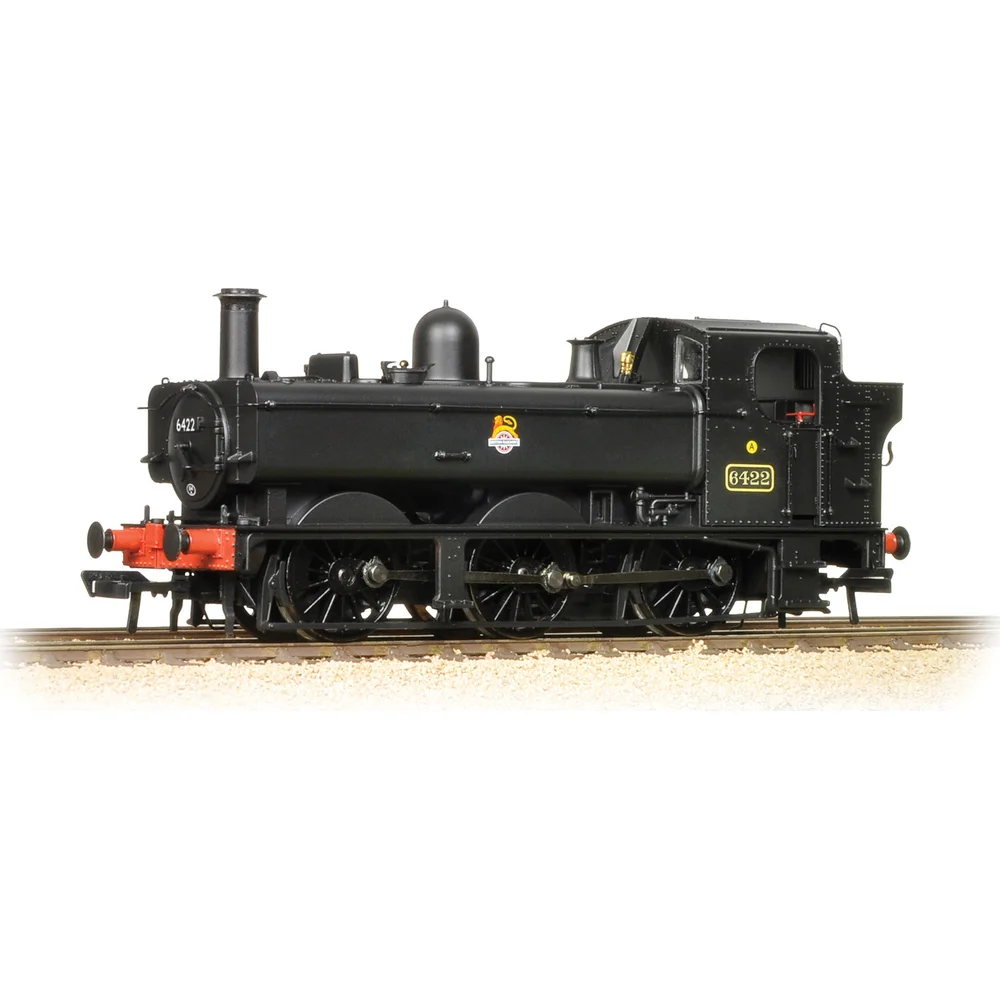Bachmann 31-636A
Great Western Railway 6400 6422 British Railways Black with Early Emblem
Tooling
Introduction & Historical Context
The Bachmann GWR Class 64xx 0-6-0PT was introduced in 2015 as a completely new tooling, designed to accurately represent the Collett-designed 64xx class of pannier tanks. These locomotives were built between 1932 and 1937 at Swindon Works, specifically for push-pull (auto-train) passenger services on GWR branch lines. A total of 40 were produced, and three survive in preservation today. The 64xx class was distinct from the more numerous 57xx and 8750 classes, with differences in dimensions, cab design, and operational equipment.
Tooling Features
- Scale: OO Gauge (1:76)
- Construction: Combination of plastic and metal chassis
- Detailing: Factory-fitted separate parts including handrails, lamp irons, pipework, safety valves, smokebox door dart, whistle and guard
- Cab: Fully detailed and painted interior with short and tall cab variants
- Couplings: NEM pockets with tension lock couplings; cosmetic screwlink couplings included
- Underframe: Brake rigging, sanding gear, footsteps, and chemically-blackened wheels
Mechanical & Electrical Features
- Motor: Coreless motor located in the locomotive
- Drive: Loco-driven wheels
- Minimum Radius: Designed to run on Radius 2 curves
- Weighting: Integrated within chassis for improved adhesion
- Lighting: No lighting fitted
- Pickups: All wheels
- Power Collection: 2-rail DC
DCC Capability
- DCC Ready: 6-pin socket
- Speaker Provision: None
Liveries Produced
- GWR Green (1835–1947)
- BR Plain Black (1948–1980)
- BR Green with Early Emblem (1948–1957)
- BR Black with Early Emblem (1949–1957)
- BR Green with Late Crest (1957–1972)
Reviews & Commentary
The model was well received upon release, with Hornby Magazine and Key Model World praising its accuracy and detailing. Reviewers noted that the tooling was entirely new and not a rehash of previous pannier tank models. The cab detailing, separately fitted parts, and smooth running performance were highlighted as standout features. Videos and reviews showcased the model running on test tracks, particularly the BR-liveried 6417.
- Sam’s Trains Review – Compares older and newer releases, highlighting build quality and value
- Moorway South Review – Covers DCC fitting, running performance, and close-up detailing
- Hornby Magazine Test Track – Features BR-liveried 6417 in realistic layout operation
- Frontington and Backwoods Railway – Showcases the 64xx in a GWR branch line setting with autocoach
- SDJR7F88 Running Session – Demonstrates BR Early Black version with sound and layout integration
Social media and forums note its appeal to GWR and BR modellers, especially those recreating branch line and auto-train operations. The model is often praised for its suitability on compact layouts and its smooth, quiet running.
Interesting Notes
- The tooling reflects the earlier body style (6400–6429) with curved cabside-bunker joins and overhanging cab roof lips.
- Designed to represent auto-fitted locomotives with screw reverse and ATC equipment.
- Footplate-mounted lubricators and front tank support variations are accurately depicted.
Class & Prototype
- Class: Great Western Railway 6400
- Traction: Steam
- Built: 1932-1950
- Total Built: 40
- Running Number: 6422
Operator & Livery
- Operator: British Railways
- Livery: Black with Early Emblem
- Era: 4 - British Railways Early Emblem
British Railways transformed Britain's fragmented rail network into a unified national system following nationalisation on 1st January 1948. Created from the "Big Four" companies under the Transport Act 1947, BR operated most of Great Britain's railways until rebranding as British Rail in 1965, managing over 20,000 route miles and inheriting nearly 20,000 locomotives of diverse designs.
The organisation pioneered standardisation through its revolutionary BR Standard locomotive programme (1951-1960), producing 999 advanced steam engines under Robert Riddles' direction. These included the versatile Britannia Pacifics, mighty 9F freight engines, and mixed-traffic classes that incorporated the best features from all predecessor companies. The 1955 Modernisation Plan accelerated diesel and electric traction development, creating fascinating mixed-traction operations.
Notable achievements included establishing unified locomotive classification systems, introducing distinctive corporate liveries, and managing the complex transition from steam to modern traction. BR's six regional structure preserved operational diversity whilst enabling standardisation of practices, signalling, and rolling stock that had eluded private enterprise for over a century.
The BR era represents steam traction's final flowering alongside emerging diesel technology, creating unparalleled locomotive variety. Today, this heritage remains highly popular with railway enthusiasts through extensive preserved fleets, heritage railway operations, and comprehensive model ranges from manufacturers like Hornby, Bachmann, and Dapol, making BR subjects essential for authentic post-war British railway modelling across all scales.
British Railways' plain black livery was designated specifically for freight and shunting locomotives from 1948, representing the most economical and practical finish for inherently dirty industrial machines. During the early nationalisation period, many locomotives were simply patch-painted over old company markings with black paint, which quickly weathered to match the existing finish as these engines were rarely cleaned. The "Lion and Wheel" emblem (nicknamed the "Cycling Lion") was introduced from December 1948 and applied to plain black locomotives from early 1949, featuring a lion standing over a large railway wheel with "British Railways" lettering across the centre.
The emblem was produced in three sizes and always faced forward, positioned centrally on tender sides or tank sides, with regional preferences evident—the Western Region favoured larger emblems whilst other regions used smaller versions. Plain black locomotives retained red buffer beams and received white "BRITISH RAILWAYS" lettering in Gill Sans style before the emblem's introduction. Some former company locomotives, particularly ex-GWR shunting engines, retained their original lettering well into the early 1960s as they didn't require renumbering and received minimal attention. This utilitarian livery remained standard for freight operations until the mid-1950s emblem change, making it essential for authentic early BR period modelling of goods yards, collieries, and industrial operations.
